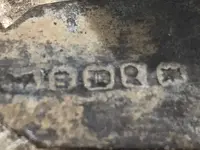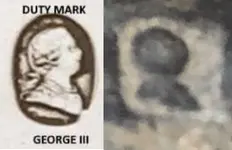This one has me stumped. It's a mid 19th century spoon, I have the bowl and complete handle. The house was burned in 1864. It's the "fiddle back" style so popular in the first part of the 19th century. I thought it was brass at first, but the marks are fooling around with me.
That being said, the first mark is for "sterling", maybe, not sure about the rest and I don't see a letter mark for the year. Can anyone figure this one out?
maybe, not sure about the rest and I don't see a letter mark for the year. Can anyone figure this one out?

That being said, the first mark is for "sterling",
 maybe, not sure about the rest and I don't see a letter mark for the year. Can anyone figure this one out?
maybe, not sure about the rest and I don't see a letter mark for the year. Can anyone figure this one out?
Amazon Forum Fav 👍
Last edited:




